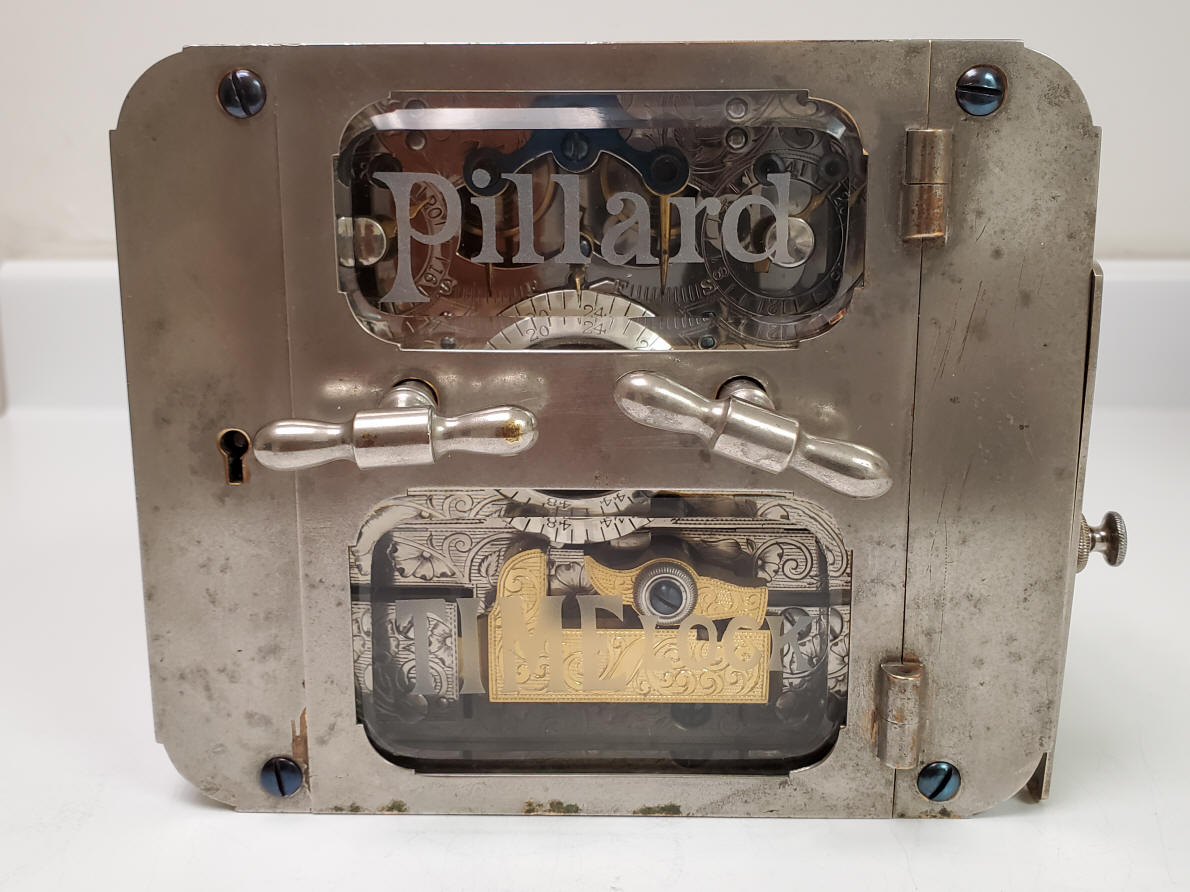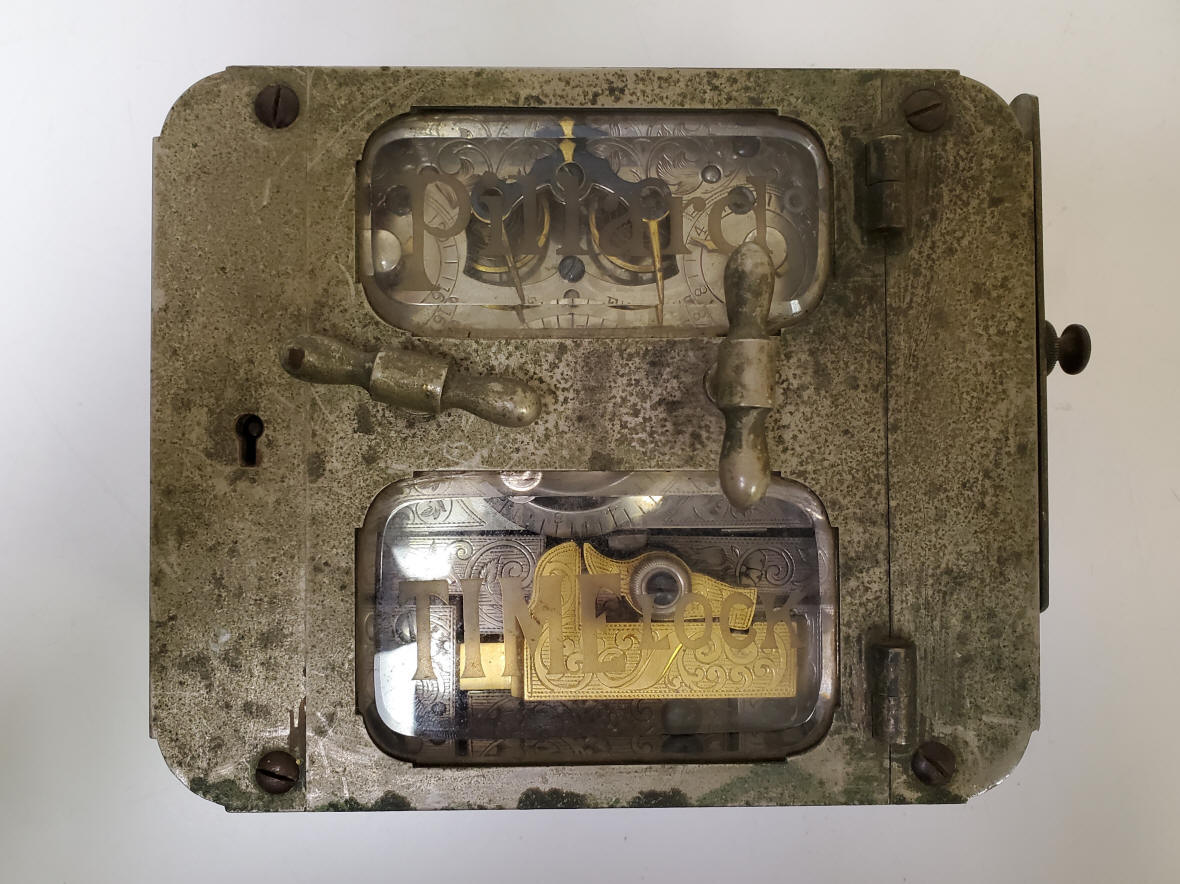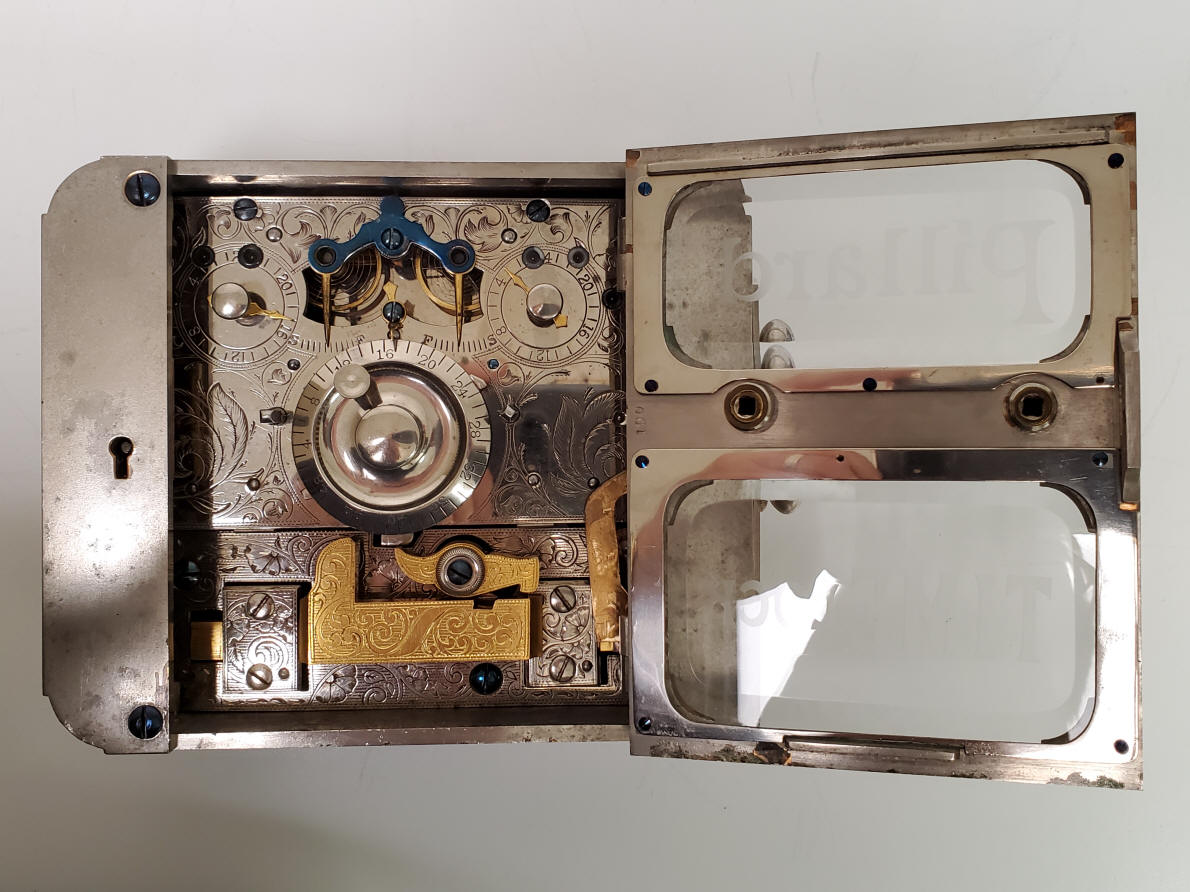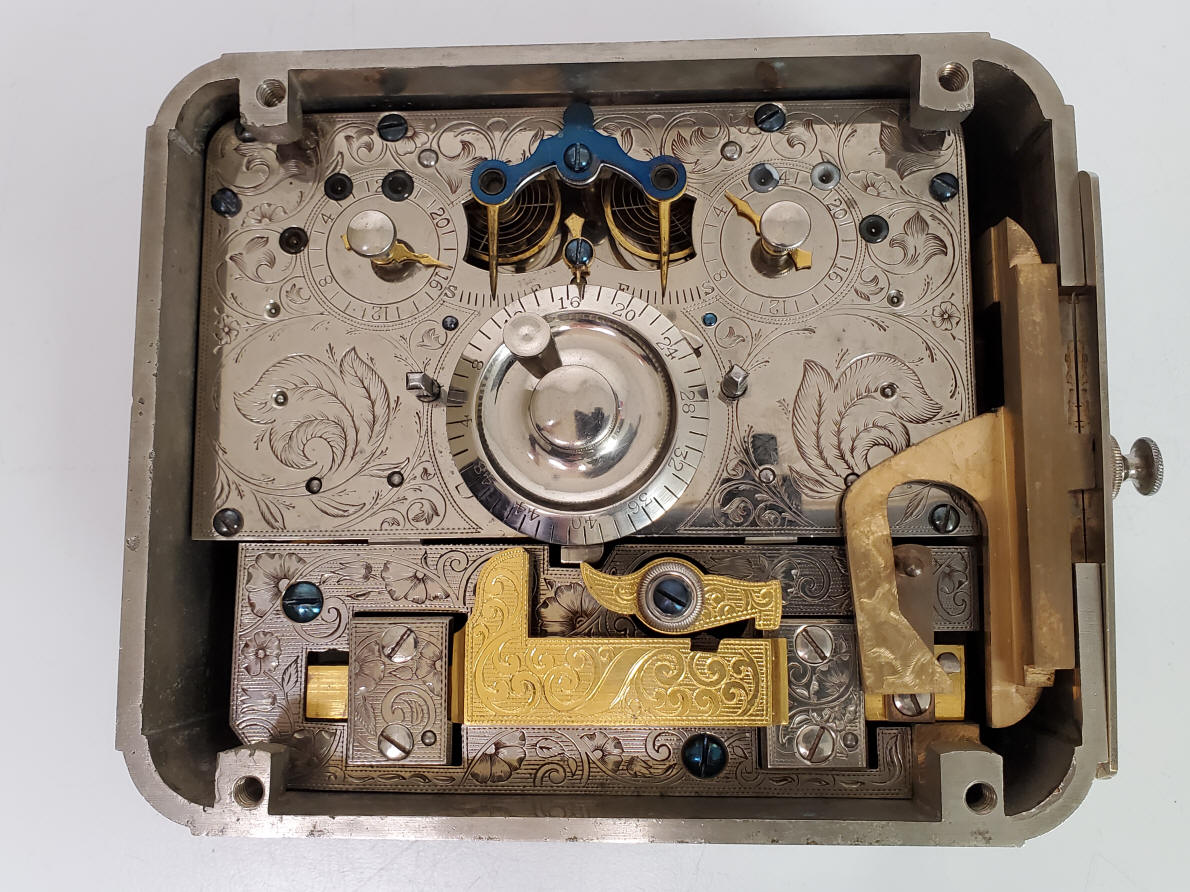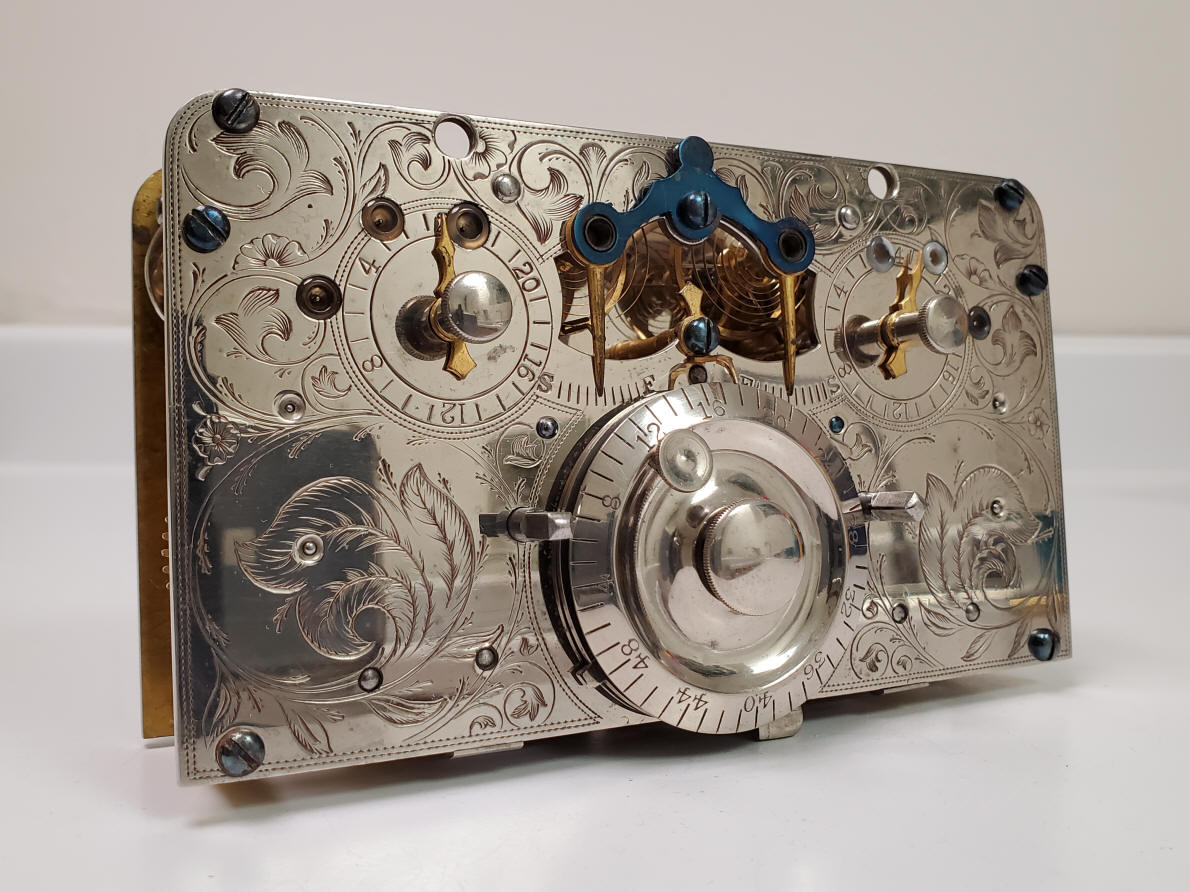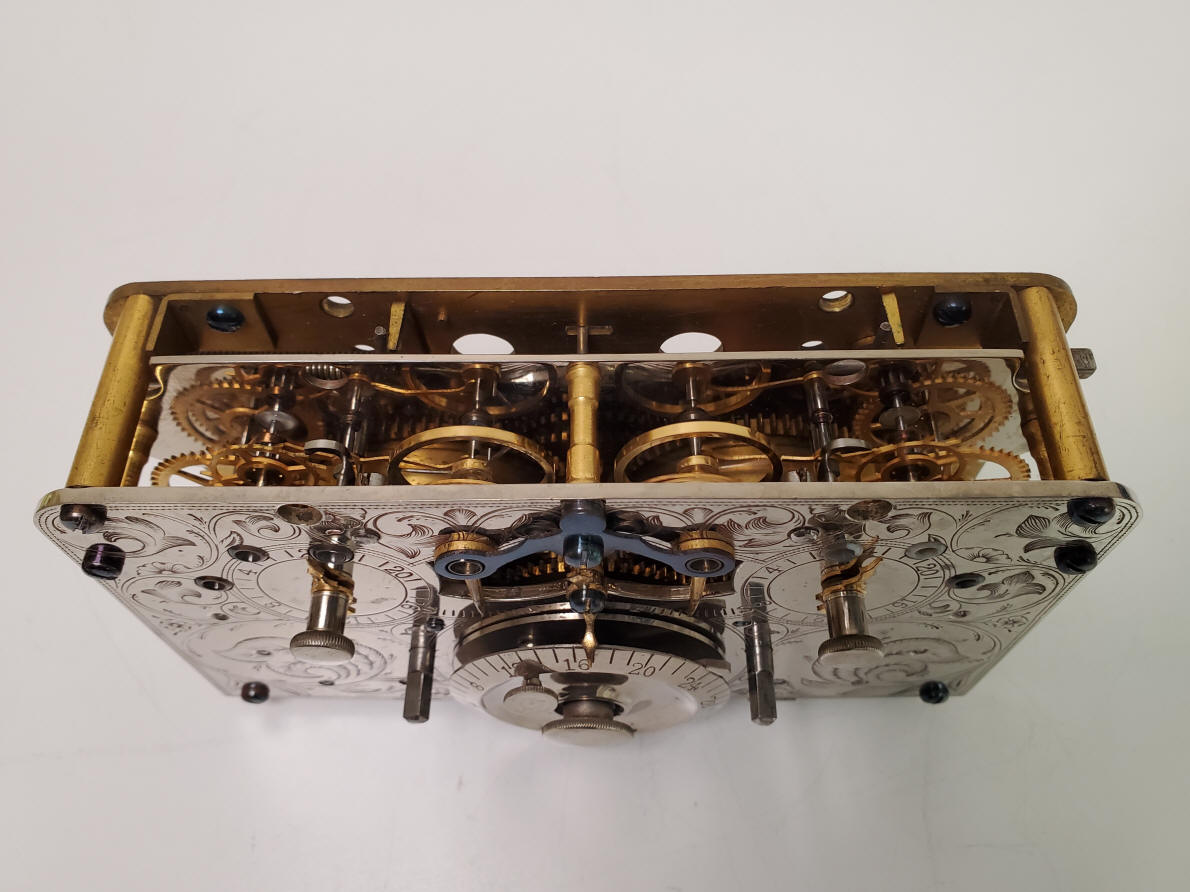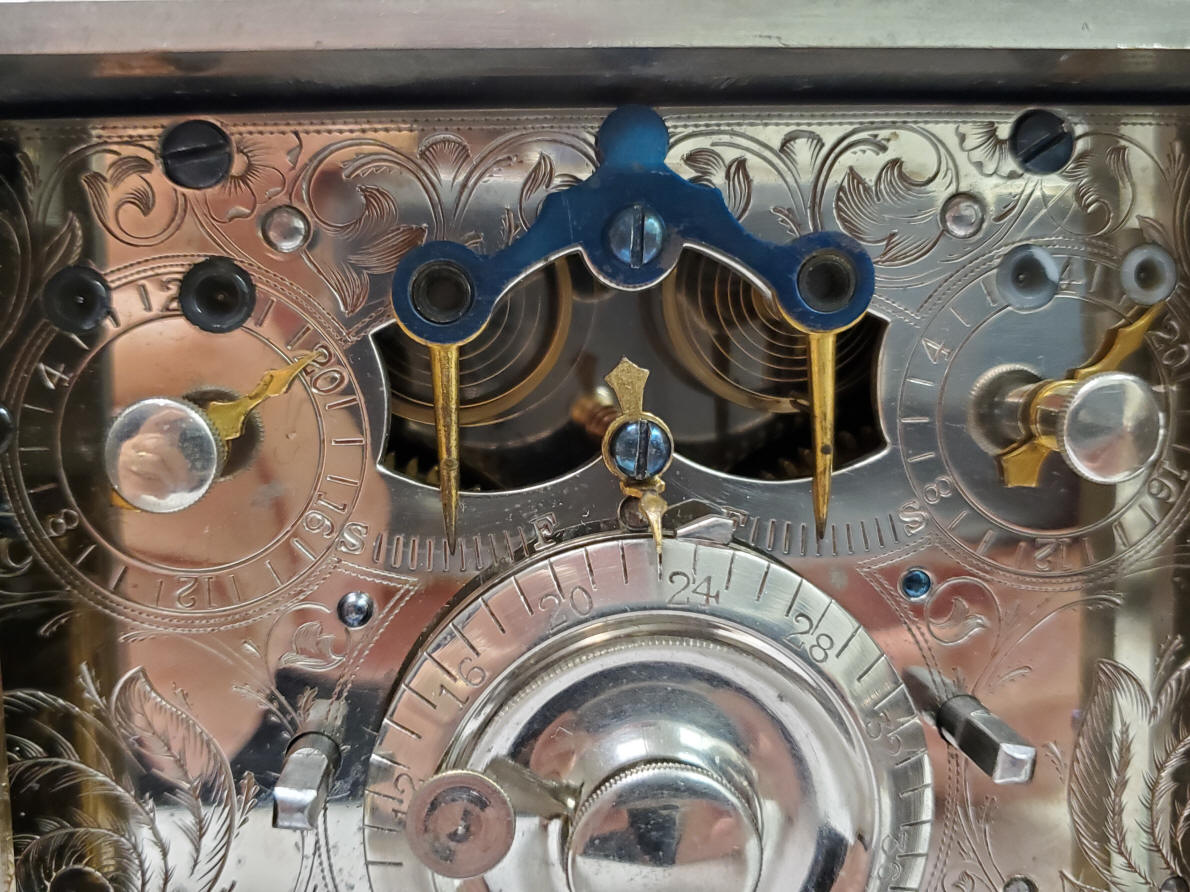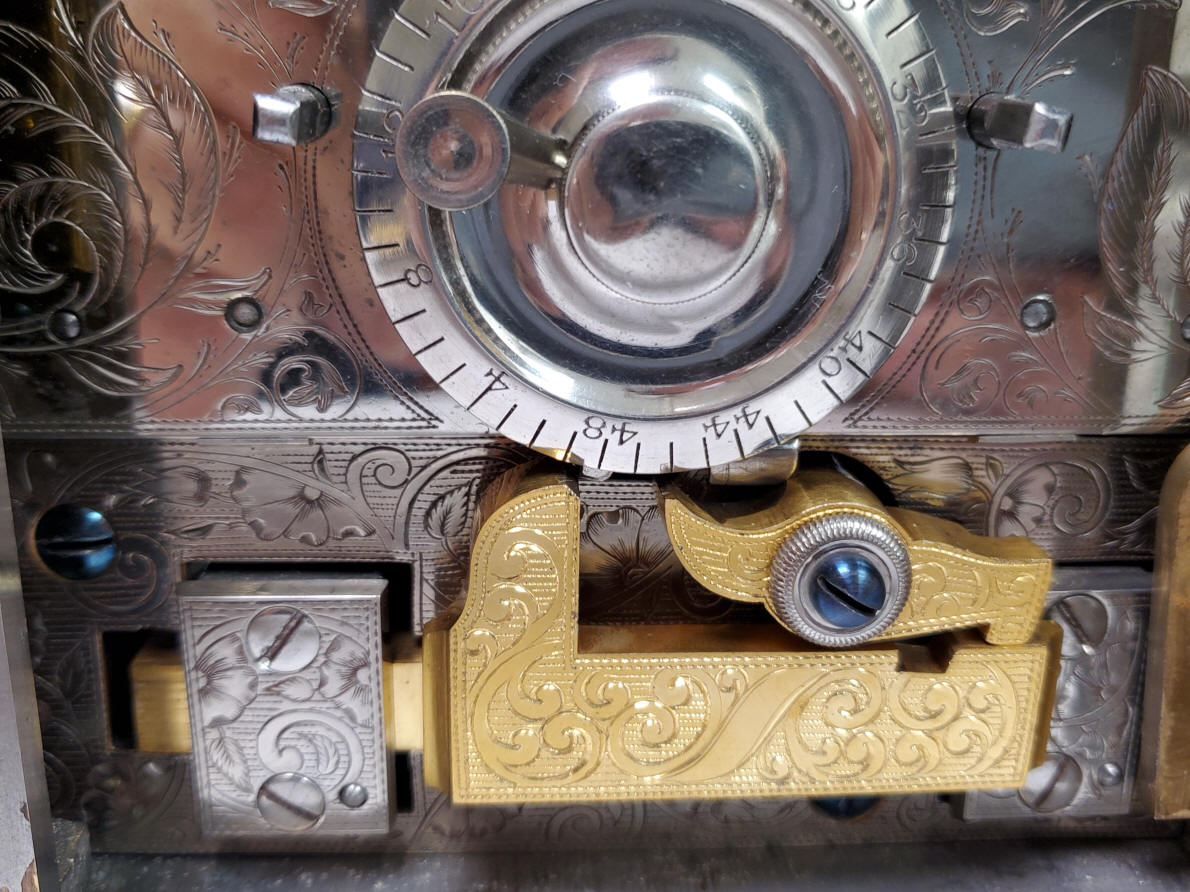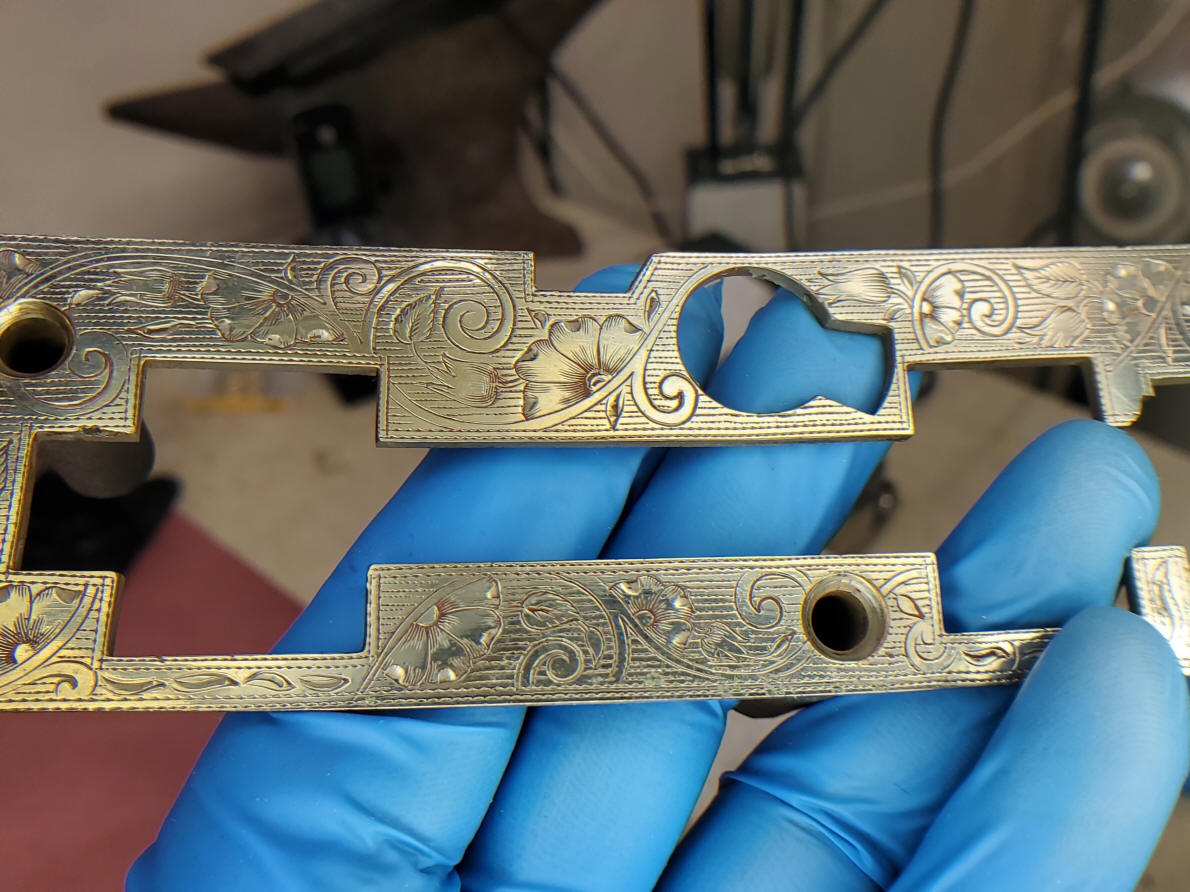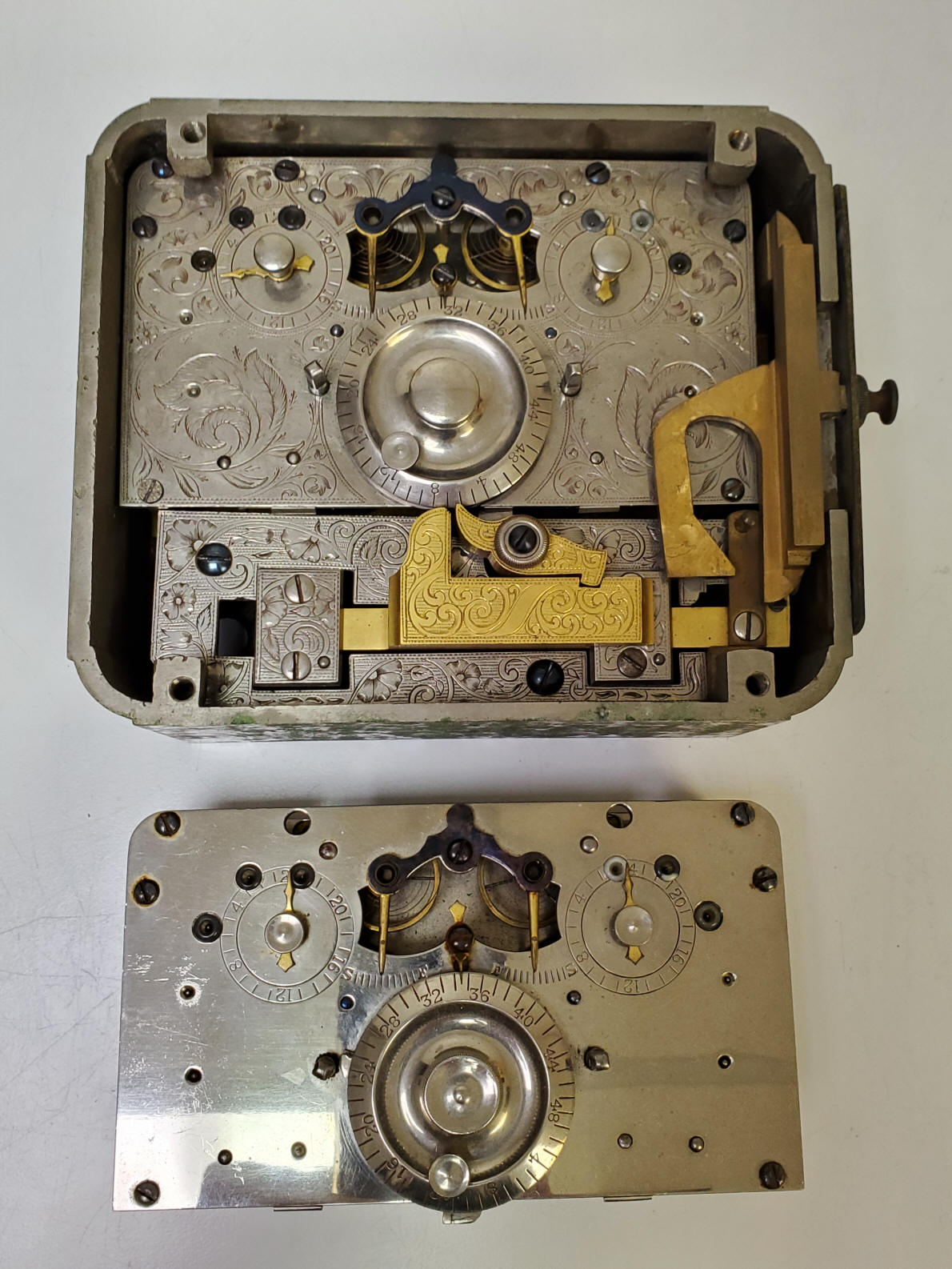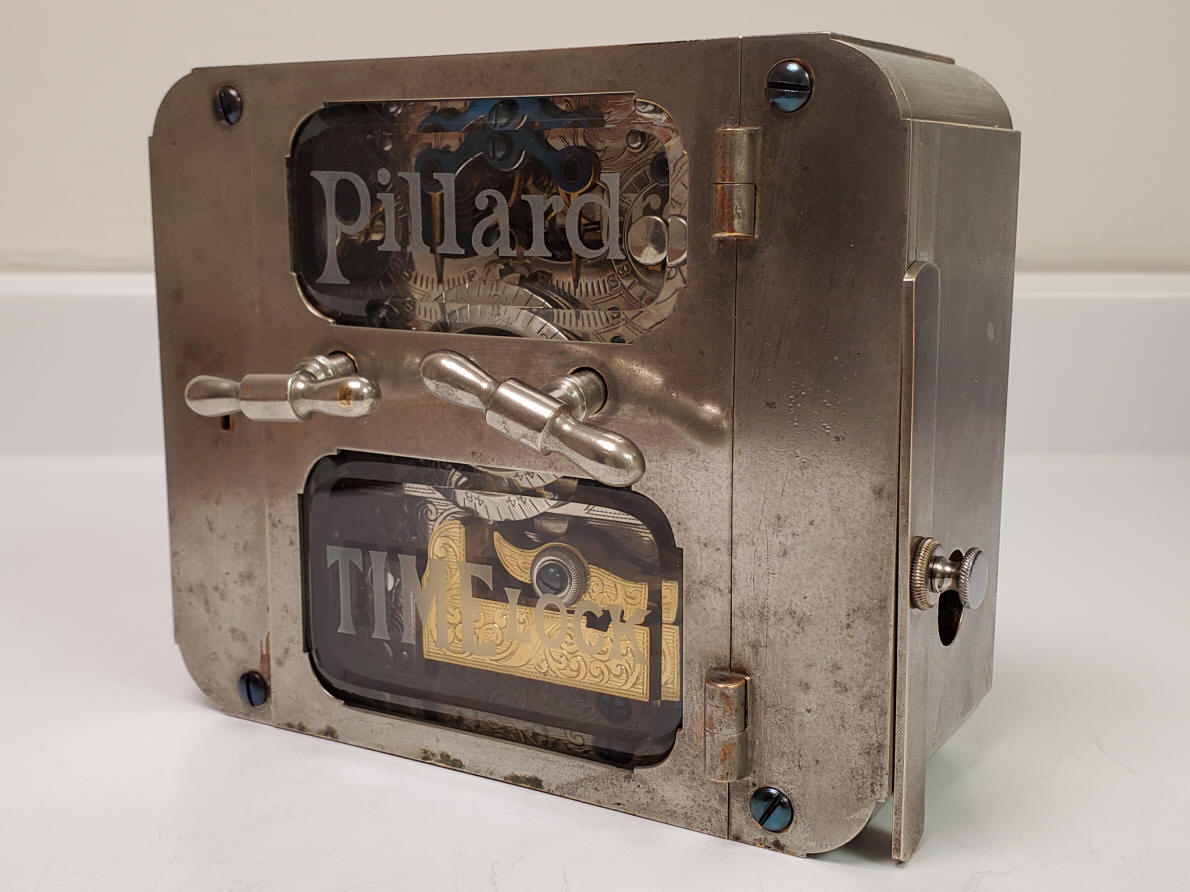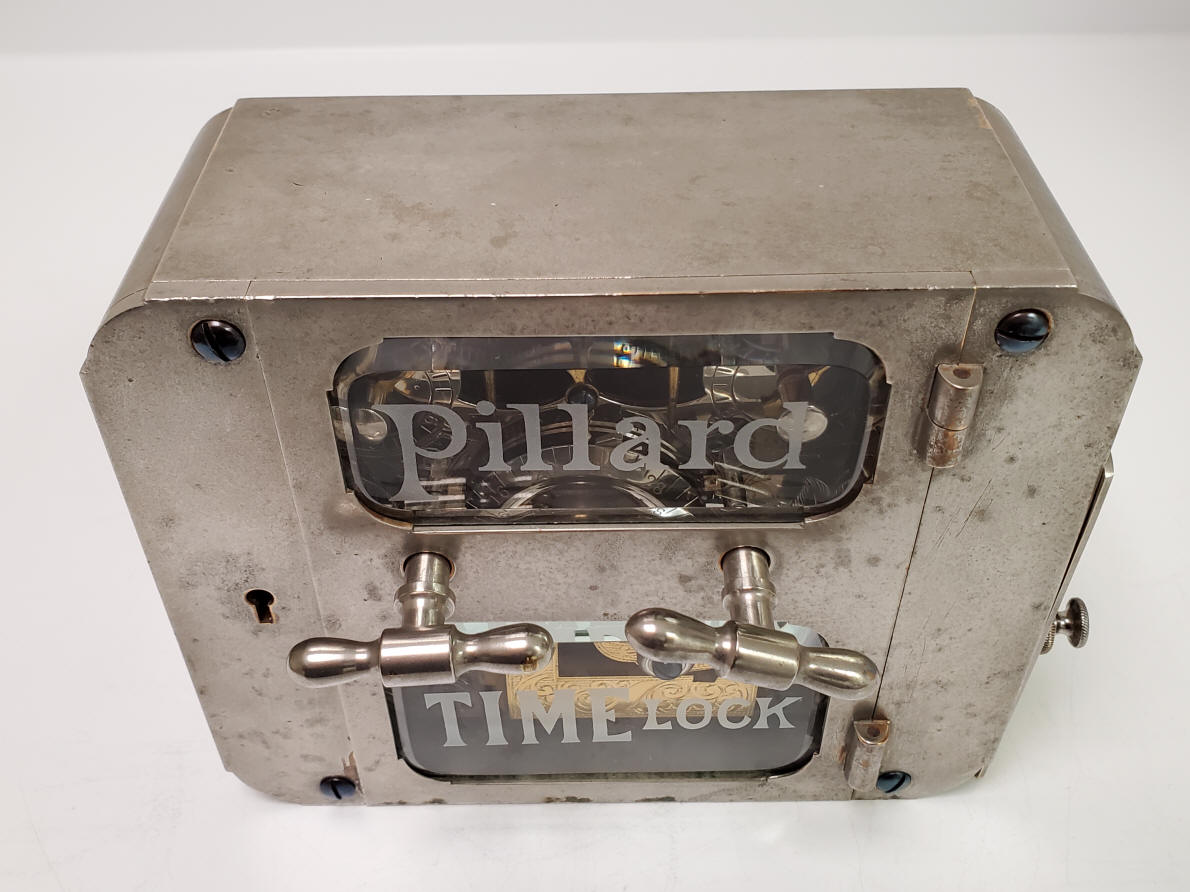|
Oliver Pillard Model #3, New Britain Bank Lock Co., New Britain, Connecticut
The original condition of the case was quite rough, below. It was impossible to bring it back to a good condition due to extensive corrosion.
The time lock in "as found" condition. The restoration of this lock can be seen here.
It is an unfortunate that the case design has the two front case strips that hold the door side panels flanking the the right and left sides of the case hides a significant amount of the engraving artwork.
This photo shows the door side panels removed, revealing more of the intricate engraving work. The Pillard line of time locks were noteworthy for their beautiful deeply incised engraving. The unusually elaborate scroll engraving was expensive, even for the time, and is similar to that found on high grade Parker Brothers shotguns from the same period. Parker shotguns of the late 1870's were made in Meridian, Connecticut, less than ten miles south of New Britain, and it is quite possible that the same craftsmen decorated this time lock.
In this photo one can see the triple-plate construction which includes a separate plate within the two main front and rear plates. This area contains the escapement components. The rest of the clockwork is between the main plates.
Upper view of the movement showing the escapements and duration dial work. Note the rouge color that is present in the engraving giving an additional depth to the design.
The slide bolt (which was in later time locks called a 'snubber bar') is gold gilt.
Slide bolt surround plate detail showing engraving and rouge infill.
This photo shows the Pillard Model 3 with another Pillard movement which, other than the engraved front plate, is identical. Until the example above was found it was thought that all of the Pillard models, with the exception of one which had a milled damascened surface similar to the case design (bottom of this page), had this plain front movement plate. See the Pillard Model 2 example in this collection as well as photos of other examples below. The Pillard model 2 has this plain movement plate but the surround plate is engraved, once again largely covered by the door side panels.
This video shows a restored Pillard time lock model #3 movement from the New Britain Lock Co. Pillard time locks are amongst the rarest in existence as Yale had won a patent infringement lawsuit against the company and aggressively pursued any bank that had one. Yale offered to avert suing if they removed the lock and replaced it with Yale's time lock and then promptly melted down the confiscated Pillard locks. The lock from which this movement comes from is the only one that has the front movement plate that is engraved.
This video demonstrates the functions of the Pillard model #3 time lock. The New Britain Lock Co. was driven out of business through patent litigation brought on by the Yale Lock Manufacturing Co. After suing, the Pillard lock was removed and replaced, at a discount, to the bank and Yale then melted down the Pillard lock. Yale and Sargent & Greenleaf were the largest makers of time locks and used a patent pool arrangement to drive out nearly all competition, a practice that would have been a violation of law after the Sherman Antitrust Act was passed about ten years later. Of the original 170 locks made by the New Britain company, over three models, seven are known at this time to have survived, with only three in private hands, the remaining in museums. The special engraving work was done by the Parker Brothers firearms company, located in Meridian, Connecticut about ten miles from New Britain. The visual beauty and rarity of of the Pillard make these some of the most coveted and expensive collectible time locks.
One of the unique features of this lock are the external winding keys mounted to the door, one doesn't have to open the door to wind the lock. Of the seven known examples of Pillard's line of locks three have these type of winders, the rest have conventional winding square arbors.
The Pillard time lock was not an easy one to operate. Beginning with the safe open, one winds and sets the time lock. Then with the door still open the bolt work is thrown shut, the power reserve catch on the side is raised until it holds, the bolt work is reopened, the safe door closed, and the bolt work thrown shut. If the minimum twenty-four hour power reserve is met, the reserve catch falls to rest on the release slide, blocking the bolt. Since the safe might seem locked at this point but is not time locked due to insufficient winding, some Pillards, as does this one, have a notice embossed on the door to wind the lock every day.¹ Pillard model #3, c. 1875. New Britain Bank Lock introduced their Oliver Pillard-designed time lock in 1875, the model #1. Based on two forty-eight hour jeweled, (this example) or fifty six hour high quality un-jeweled movements made by Laporte Hubbell, Forestville, Connecticut. Shortly after the introduction of their first model, three subsequent models were introduced nearly simultaneously. Those models all used a second style of clock movement than that used in the first model but was also made by Laporte Hubbell. While using the same movement each subsequent model had slightly differing bolt dogging configurations and case designs. The Pillard was the first to feature power reserve indicators that would prevent the lock from closing with less than twenty-four hours power remaining. Such a power reserve indicator (albeit without low-power anti-locking) wouldn't be seen again until Yale's B, C, D and E models of 1888. The unusually elaborate scroll engraving was expensive, even for the time, and is similar to that found on high grade Parker Brothers shotguns from the same period. Parker shotguns of the late 1870's were made in Meridian, Connecticut, less than ten miles south of New Britain, and it is quite possible that the same craftsmen decorated this time lock. New Britain's Pillard lock was quite successful and some 170 were made and installed by 1877. This success made them a prime target for patent litigation from the Yale Lock Manufacturing Company. At this time many makers had issued letters and flyers claiming patent rights and identifying other time lock makers as selling infringing designs, but none had ever brought suit. In response makers commonly offered to repurchase their time locks and indemnify banks for any costs, should their time locks be ruled infringing. A landmark decision involving Yale and the City National Bank of Bridgeport in 1877 favored Yale and issued a permanent injunction against New Britain Bank Lock from producing its time lock, the firm was forced to reimburse City national Bank for the Pillard time lock. Although this single decision was small, both Yale and Fredric North, the owner of New Britain, realized its sweeping consequences: any bank that Yale could locate with a Pillard time lock could be forced to remove the lock. As part of an aggressive campaign, Yale offered to sell these banks their Yale Double Pin Dial locks at a reduced price if they surrendered their "infringing" Pillard time locks to Yale. Many banks accepted these terms and Yale promptly melted down the the Pillard time locks they received, making the Pillard among the rarest time locks today. North and new Britain continued for a while, but with New Britain not being incorporated, the mounting losses were being passed directly to North, and he was soon forced to close his doors. (1) A model example of how Yale and Sargent and Greenleaf used litigation to crush competitors. There are seven other Pillard time locks known to exist. A gold-plated damascened example of the model #2 survives in the Science Museum, London as well as a brass damascened case in this author's collection. Two other examples of the model #2 with the polished nickel surface are first in the Harry Miller Collection, (see first photo below), second in LIPS Lockmaker Collection, Amsterdam. An example of the model #1, later, gold plated, is in the Mossman collection located in the General Society of Mechanics and Tradesman Museum, New York City, last two photos below, and a nickel plated version in a private collection. Two examples of a the model #3 are known; one is located in the Lock Museum of America (see second photo below), and this example above discovered in 2023, with nickel plated case and full engraving on the movement front plate matching the lock body is described here in this author's collection. 5 1/2"h x 6 5/8"w x 2 5/8"d, case #190, movement unnumbered. file 356 The first photo below shows a Pillard Model 1 in the Harry Miller collection. The next photo is a Pillard model #3 which was a low profile model designed for use in safes with tighter bolt works. Possibly a special order design Pillard with gold plated finish remains today as part of the collection at the Lock Museum of America, Terryville, Connecticut, second. third photo. This looks to be a salesman sample in a wood case. (see below). ¹ A second Model 3 example described above, was found in 2023 in a silver cased, split window design. The last two photos show a gold plated Pillard Model 1 in The General Society of Mechanics and Tradesman Museum, New York City.
Pillard Model 1, Harry Miller Collection, Nicholasville, KY Pillard Model 3, Lock Museum of America, Terryville, Connecticut
This is the only other example of a Pillard that had decoration on the front movement plate, it is a milled damascene design that appears to match that of the case. Pillard Model 3, Lock Museum of America, Terryville, Connecticut.
Example from the LIPS collection, Netherlands.
Pillard Model 1, Mossman Collection, The General Society of Mechanics and Tradesman Museum, New York City.
|
|
(1) American Genius Nineteenth Century Bank Locks and Time Locks, David Erroll & John Erroll, pp. 186-189 |
